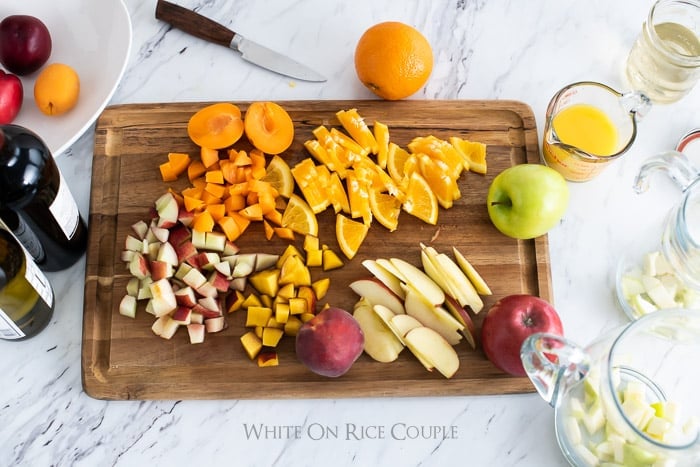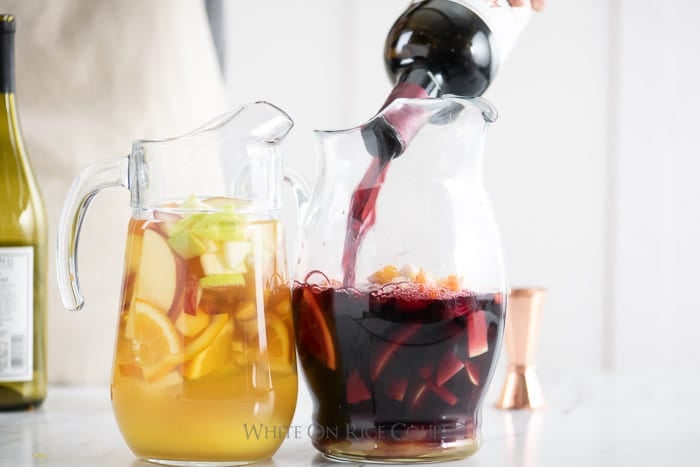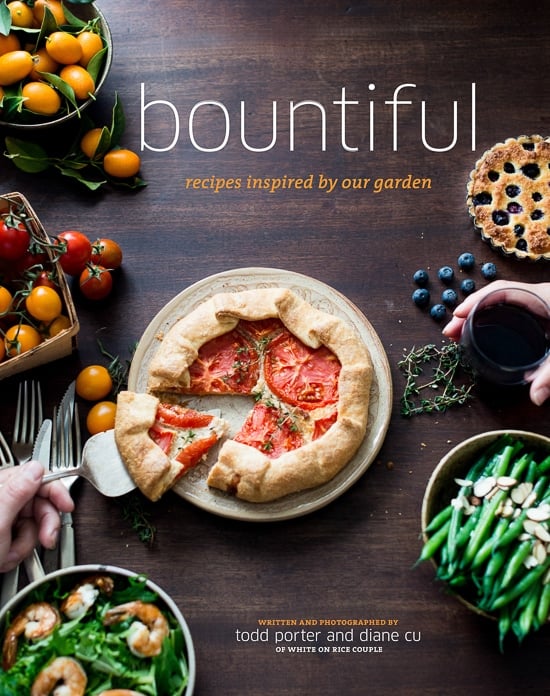Sangria Wine Time : Red, White or Rose
Easy Sangria Recipe
We weren’t immediate fans of Sangria at first. The first few times we sipped this popular Spanish drink was in restaurants and they were often too sweet, too bitter or just blah. We knew Sangria didn’t have to taste like bad fruity wine and there were more possibilities to this refreshing drink. After a few homemade tests with our sangria wine recipe, we’re now hooked. Making it to your personal taste is SO MUCH better, friends. A little bit of this, a little bit of that and boom, it’s a personalized pitcher of refreshing goodness that we can’t stop drinking. When the weather is warm and sitting outside with a few glasses of sangria is a perfect afternoon. Life is good when your pitcher of sangria is cold, customized and refreshing.
Best Red Wine and White Wines for Sangria?
Most dry Spanish wines are perfect for sangria (after all, it is the home of the sangria). Sangria’s aren fussy, so don’t feel limited to your choices. And you don’t have to use an expensive bottle of wine. Our general recommendation is to have fun, pop open a bottle that is pleasant to drink, but not so pricy that it gets lost in all the additions. We’ll usual stick with drier wines, as you are already adding sweetness to the wine when making the sangrias, and it is easy to quickly become too sweet. For any wine, adjust the fruit & sweetness to your preference.
- Red Favorites: Traditionally, Spanish sangria is made with rioja and or a combination of tempranillo/garnacha grapes. So Grenache, Tempranillo, Zinfandel, Red blends-particularly Spanish style blends & Rhone Blends are great.
- White Wine Favorites: Sauvignon Blanc, Chablis (or other dry, unoaked Chardonnays), Albarino, Pinot Gris
- Rosé & Other Favorites: Grenache Rosé, almost any dry rosé, a nice dry sparkling Cava or Prosecco
Video: How to Make Sangria:
What Fruit to Use for Sangria?
There’s so many fruit options, the possibilities are endless. Use ripe fruits that you’ll want to eat and that will also complement the existing flavors of the wine. Or you can use fruit to counterbalance the Sangria. For example, if you’re using a sweet wine, try adding a touch more orange juice or citrus to balance out the flavors. Or if you really love your drink to be sweet, add some muddled berries and really ripe stone fruits. It’s hard to go wrong with most fruits and best of all, eating the infused fruit is the extra special treat at the bottom of the glass.
- Apples and Pears
- Stone fruits: Peaches, nectarines, plums
- Berries: Blueberries, strawberries, black berries
- Melons
- Kiwi
- Oranges, Tangerines, Mandarins
- Cinnamon Stick (isn’t a fruit, but it adds a nice sweetness and fragrance)
Ice, No Ice, Fizzy?
You can do either, or or all. There’s different schools of thought about ice and it’s more about personal taste. Some folks don’t like ice because they don’t want their sangria watered down. We personally like to ice our Sangria because it makes the drink extra cold. It’s refreshing to have a cold drink on a hot day. If you don’t like it flat and you can add a splash of carbonated soda, light soda or something fizzy. You can also use a sparkling dry wine, such as Cava or Prosecco. There’s something for everyone when you start with a great pitcher and everyone will be happy and refreshed.
Enjoy and as always friends, drink responsibly.
-Diane and Todd
Check out more of our Cocktail Recipes Here.

Sangria Recipe (Red, White, or Rosé)
Ingredients
- 1 (750 ml) bottle dry red, white, or rosé wine , chilled *see note below
- 2 cups chopped fruit (apples, peaches, nectarines, melon, berries)
- 1 small orange , cut into thin pieces
- juice of 1 orange or 1/2 cup orange juice
- 1/4 cup brandy , rum, grand mariner etc., or to taste
- 2 Tablespoon simple syrup , or to taste
- 3-4 cups (optional) ice
- (optional) extra slices of fruit for garnish
Instructions
- Add your chopped fruit and cut orange slices in a large pitcher. For more fruity flavor, you can muddle a few pieces of the fruit.
- Add wine, orange juice, brandy, & simple syrup to taste. Stir to combine.If you’re making this ahead, you can cover and chill the sangria at this point. We like making the sangria a day ahead or chilling for at least 3 hours so all the natural fruit flavors combine with the wine.
- Before serving, add ice to your individual glasses (or have an ice bucket out for everyone to serve themselves), stir and serve with some slices of fruit for garnish.
Notes
Most dry Spanish wine are perfect for sangria (after all, it is the home of the sangria). Sangria’s aren fussy, so don’t feel limited to your choices. Our general recommendation is to have fun, pop open a bottle that is pleasant to drink, but not so expensive that it gets lost in all the additions. We’ll usual stick with drier wines, as you are already adding sweetness to the wine when making the sangrias, and it is easy to quickly become too sweet. For any wine, adjust the fruit & sweetness to your preference.
Red Favorites:
Grenache, Tempranillo, Zinfandel, Red blends-particularly Spanish style blends & Rhone Blends
White Favorites:
Sauvignon Blanc, Chablis (or other dry, unoaked Chardonnays), Albarino, Pinot Gris
Rosé & Other Favorites:
Grenache Rosé, actually - almost any dry rosé, nice dry sparkling Cava or Prosecco Note 2: A basic simple syrup is a 1:1 ratio of sugar dissolved in water. We'll usually make 1 cup sugar heated & dissolved in 1 cup of water. Let it cool before using. We usually make larger batches and keep on hand in the refrigerator.
Video
Nutrition Information per Serving
Hope you enjoy our sangria wine recipes! Here’s a great list of Sangria ideas.

















This is my favorite sangria recipe. I can’t wait to make it this Summer.
I’m in love with this sangria recipe. I love customizing the flavor to my mood. Really great for Summer.
It’s been getting so hot here and this sangria recipe was the perfect way to get through the heat. Absolutely loved it!
These Sangrias were so perfect over the weekend. I’m looking forward to spending all Summer long with your Sangria recipes.